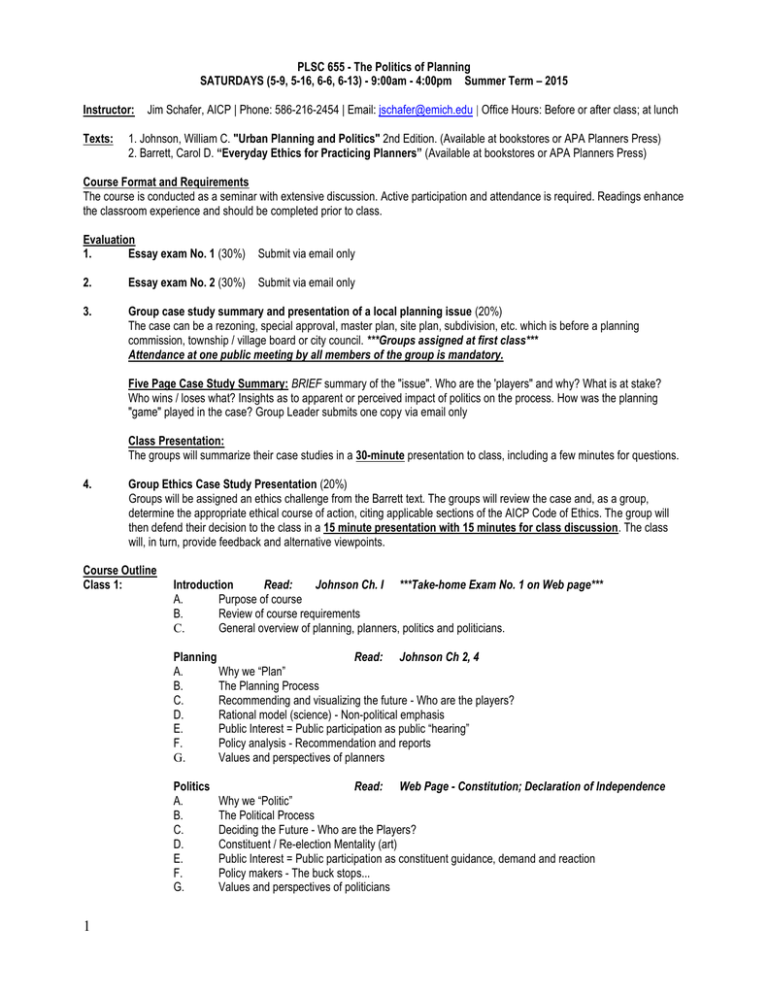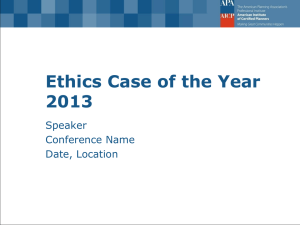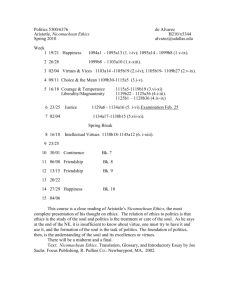PLSC 655 - The Politics of Planning
advertisement

PLSC 655 - The Politics of Planning SATURDAYS (5-9, 5-16, 6-6, 6-13) - 9:00am - 4:00pm Summer Term – 2015 Instructor: Texts: Jim Schafer, AICP | Phone: 586-216-2454 | Email: jschafer@emich.edu | Office Hours: Before or after class; at lunch 1. Johnson, William C. "Urban Planning and Politics" 2nd Edition. (Available at bookstores or APA Planners Press) 2. Barrett, Carol D. “Everyday Ethics for Practicing Planners” (Available at bookstores or APA Planners Press) Course Format and Requirements The course is conducted as a seminar with extensive discussion. Active participation and attendance is required. Readings enhance the classroom experience and should be completed prior to class. Evaluation 1. Essay exam No. 1 (30%) Submit via email only 2. Essay exam No. 2 (30%) Submit via email only 3. Group case study summary and presentation of a local planning issue (20%) The case can be a rezoning, special approval, master plan, site plan, subdivision, etc. which is before a planning commission, township / village board or city council. ***Groups assigned at first class*** Attendance at one public meeting by all members of the group is mandatory. Five Page Case Study Summary: BRIEF summary of the "issue". Who are the 'players" and why? What is at stake? Who wins / loses what? Insights as to apparent or perceived impact of politics on the process. How was the planning "game" played in the case? Group Leader submits one copy via email only Class Presentation: The groups will summarize their case studies in a 30-minute presentation to class, including a few minutes for questions. 4. Group Ethics Case Study Presentation (20%) Groups will be assigned an ethics challenge from the Barrett text. The groups will review the case and, as a group, determine the appropriate ethical course of action, citing applicable sections of the AICP Code of Ethics. The group will then defend their decision to the class in a 15 minute presentation with 15 minutes for class discussion. The class will, in turn, provide feedback and alternative viewpoints. Course Outline Class 1: Introduction Read: Johnson Ch. I ***Take-home Exam No. 1 on Web page*** A. Purpose of course B. Review of course requirements C. General overview of planning, planners, politics and politicians. Planning Read: Johnson Ch 2, 4 A. Why we “Plan” B. The Planning Process C. Recommending and visualizing the future - Who are the players? D. Rational model (science) - Non-political emphasis E. Public Interest = Public participation as public “hearing” F. Policy analysis - Recommendation and reports G. Values and perspectives of planners Politics A. B. C. D. E. F. G. 1 Read: Web Page - Constitution; Declaration of Independence Why we “Politic” The Political Process Deciding the Future - Who are the Players? Constituent / Re-election Mentality (art) Public Interest = Public participation as constituent guidance, demand and reaction Policy makers - The buck stops... Values and perspectives of politicians Class 2: Planning and Politics Read: Johnson Ch. I, 3, 5-10 ***Take-home Exam No. 1 due Prior to Class via email only*** A B. C. D. E. F. Conflict and compromise - Planning as a political process. Divergent values Long-run vs. short-run One best way vs. compromise Wide vs. narrow view of the "public interest" The policy-making process in planning The planner as a player in a political world Organizational structure - Power and authority - government departments, boards and commissions. The intergovernmental dimension State enabling legislation and Dillon's Rule State pre-emption of local control State, County, Regional agencies Federal agencies ***Read Ethics Material Posted on Class Web page*** ***Take Home Exam No. 2 on Web page*** Class 3: Planning Administration, Management and Ethics ***Take-home Exam No. 2 due Prior to Class via email only*** Planning Administration & Management – This Stuff is “Political”? A. Budgets and budgeting B. Capital Improvement Planning C. Enforcement and the courts D. Filing/case monitoring; Documentation Ethics in Planning Read: Barrett - All; Web page - Ethics Links / Codes; Review Johnson Ch. 2 A. Definitions and issues B. APA and AICP Codes of Ethics C. Group Scenario Presentations and discussion Class 4: Case study presentations and Capstone Discussion Case Study Presentations by Groups ***ALL case study summaries due prior to class - Group Leader submits one copy via email only*** Planning in a political world Read: Johnson Ch. 11 A. Who do planners work 'for"? B. Conflict and compromise – Good, bad, or? C. Accountability - To whom and for what? D. Public participation - Who, when and why? E. Can planners avoid politics? Should they try? F. Can politicians avoid planning? Should they try? Planning and Politics - Oil & Water or Instant Soup? 2 Case Study Summary A case study is an excellent way to learn about the political aspects of planning. The following guidelines are intended to assist you in preparing your case study summary: 1. Finding a case. The best cases are those which provide clear illustrations of the interplay between planning and politics. Look for cases that have issues regarding the planning process itself, allocation of values within a planning process (who gets / doesn't get what), goal setting, land use conflicts, and development reviews. 2. Determine the key issues. These may be obvious or quite difficult to discern. Identify them (legal, social, environmental, fiscal, personal). 3. Identify the players and their interest(s) in the case. Why are they playing in this particular case? What do they have to gain or lose? 4. Chronicle primary events (BRIEFLY). How did the case proceed? 5. What was the result? Who did what to who & why... What was the outcome? How was the planning game played? Do you agree / disagree with the outcome? Was the planning process effective? Why / Why not? How To Present Your Case Study - A Guide An important part of case analysis is sharing findings with colleagues for review and comment. It is also an excellent way to practice public speaking skills. The following outline is intended to provide some direction in preparation for case presentation. These are not requirements - they are suggestions to assist in structuring presentations. 1. Be on time! If you are 10 minutes early you are 20 minutes late… 2. Practice beforehand. Do not read the case study verbatim. 3. If visual aids are used, make sure they are clear, visible to the entire room, and that you practice using them. Make sure the computer and projector actually work! 4. Begin with a general case summary - who, what, where, when, and why... Then move quickly to specific issues raised by the case which relate to the main theme of the course - planning in a political world. 5. Finish with a summary of the case, key points, and lessons learned from the study about planning and politics. Presentations will be evaluated for group preparedness, content, clarity, focus, and conclusions. Was the group ready? Was the case communicated in a clear, focused, concise and thorough fashion? Were the presenters poised, confident, and comfortable? Did the presentation start on time and stay within the time allotted? Please note that presentations will be limited to a maximum of 30 minutes - including questions. Please practice beforehand to ensure that limit is not exceeded. Being cut-off due to time does not allow you to get your points across and limits the overall quality of your presentation. Practice will reduce this possibility. Remember – The Class is your “client” and you are the team presenting your findings. We expect you to be ready. Don’t waste our time figuring out the laptop or waiting for a late group member. That won’t cut it in the real world or ours… All group members are expected to attend the public meeting, contribute to the case study summary and presentation. You will not get to choose who you work with in the real world or in this class. One final thought - A planner’s client expects excellence – both in performance and in product. Work out issues behind the scenes and resolve them so the client sees only a professional finished product. 3





